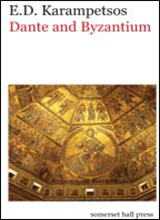E.D. Karampetsos - Dante and Byzantium. Reviewed by Gregory B. Stone
(Religion and Literature 43.1, Spring 2011. Gregory B. Stone is professor at Louisiana State University.)
The aim of E.D. Karampetsos’s Dante and Byzantium is to show that certain fundamental aspects of Dante’s comedy, on both the aesthetic and the philosophical-theological levels, are best understood in the context of the postclassical Greek traditions in which they are rooted. This is a laudable effort to show Dante’s syncretism and openness to influences from the Near East. “Byzantium” here is used in a broad sense to signify not only Byzantine art in the proper historical sense but also Greek-language philosophy and theology of late antiquity – namely, the writings of Plotinus and Pseudo-Dionysius the Areopagite. Karampetsos, asserting – without substantiating evidence – that Dante had contempt for the Greeks (37), argues that Dante represses a profound and hidden debt to “Byzantine” ideas and styles. He similarly argues that modern Dante scholarship, with some exceptions, “sees only the Latin texts, as though Byzantium and a thousand years of Greek history never existed” (142).
Karampetsos assumes a posture of heterodoxy in insisting that the Comedy’s foundations are non-Western (i.e., non-Latin), and he suggests that mainstream Dante criticism has resisted – for reasons having to do both with ethnocentrism and narrow disciplinary specialization – tracing Dante’s origins back to anything other than the Western European tradition. And while in some cases this may be true (one thinks of the scandal – which has not entirely died out – caused in 1919 by Miguel Asin Palacios’s La Escatologia musulmana en la Divina Comedia, which argued that Dante’s great poem was heavily influenced by Islamic sources), it is not so in the case of the two main figures treated here. Like the Greek Church Fathers, Plotinus and Pseudo-Dionysius have long since been recognized as important contributors to the storehouse of ideas that circulated in the Latin West, and a great many Dante scholars have espoused the Neoplatonic (Plotinian) and negative theological (Pseudo-Dionysian) views which Karampetsos presents as novel perspectives. The thesis falters because these so-called “Byzantine” influences have not in fact been overlooked.
Still, if the claims that this is a new approach to Dante, revealing a heretofore repressed key to understanding the Comedy, is untenable, the book’s three main lines of discussion are of interest and worthy of consideration. The chapter titled “The Presence of the Byzantium in Florence” makes a good case for the thriving presence of artists of Byzantine origin and manner in Florence in the age of Dante. The chapter then argues that Dante’s narrative style and organization were influenced by his having viewed the magnificent mosaic dome ceiling of the Baptistry of San Giovanni in Florence. The lack of illustrations (the reproduction of the book’s cover of a photo of a portion of the ceiling being the sole exception) makes it difficult for the reader to follow the author’s advice to compare Dante’s narrative vignettes with those of the mosaic.
The chapter’s most original point is an attempt to explain why Christ is in effect absent from Dante’s poem. Karampetsos speculates that Dante, gazing at the mosaic ceiling,
would have been struck by the massive dimensions of the figure of Christ with respect to everything else depicted; Dante would have come to think of Christ as being everywhere, an all-embracing, invisible but tacit presence throughout the cosmos. But this notion that Dante’s invisible Christ is grounded in the mosaic’s pre-eminently visible Christ is counter-intuitive, and Karampetsos offers no evidence from the text of the Comedy to support his speculation. A more fruitful encounter between the mosaic and Dante’s text might have been produced by considering the ceiling’s strikingly “encircled” Christ in relation to Dante’s representation of Christ as “painted” within a circle (Paradiso 33). The book’s next chapter, “Byzantine Renaissance,” argues that Dante’s thought is essentially Neoplatonic in the mode of Plotinus. Here Karampetsos presents a rather simplistic Dante who aims to teach that the spiritual is superior to the material and the heavenly higher than the earthly. Besides reducing Dante to a purveyor of platitudes, this chapter misrepresents the main thrust of Dante’s thought, which is certainly more Aristotelian than it is Platonic. Dante’s importance is one of the inaugurators of modernity lies in the fact that he legitimates the value of this-worldly, earthly materiality while rejecting Gnostic-style dualism. The book closes with a chapter situating Dante’s mysticism in the tradition of negative theology most notably associated with Pseudo-Dionysius. Here Karampetsos is on firmer ground, and his notion that Dante closes Paradiso with “images so unlike what they represent that there could be no possibility of confusing one with the other” (123) offers insight into the fact that Dante does not claim to offer truth concerning the essence of the divine. Still, this chapter and the book in general are marked by a lack of philosophical precision that can lead to serious misunderstandings. For example, Karampetsos says that when Dante speaks of “the part of me / that You created last” (Paradiso 1.73-74) he is referring to his soul (133). In fact, Dante is referring to the intellect, not the soul. In the Arabo-Aristotelian tradition to which Dante belongs, this distinction between soul and intellect is not a trivial matter but is bound up with nothing less than questions concerning the possibility of salvation and the immortal afterlife.
In good comparative fashion, Dante and Byzantium covers much ground and makes for pleasant and occasionally provocative reading. But, lacking real engagement with Dante scholarship and close analysis of Dante’s Comedy, this is not a substantial book for scholars and students of Dante.

